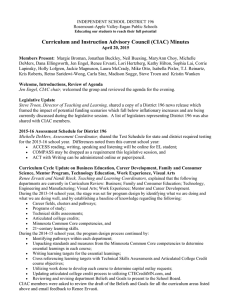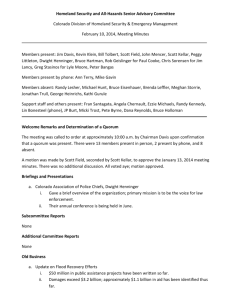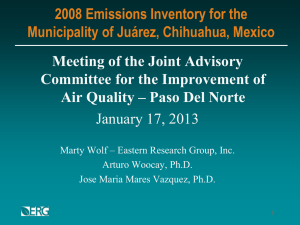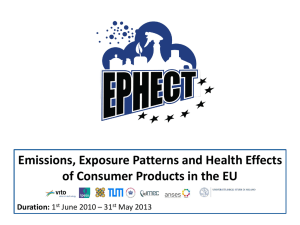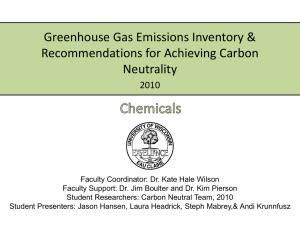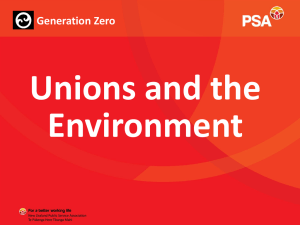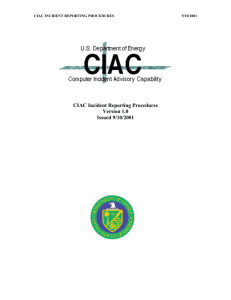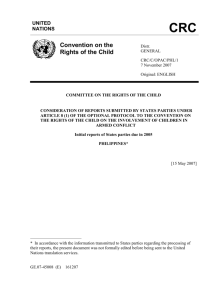Presentation
advertisement
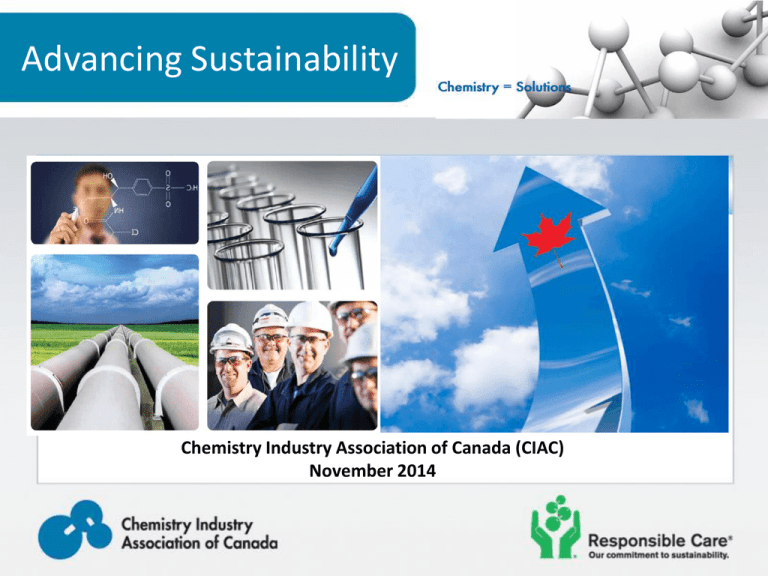
Advancing Sustainability Chemistry Industry Association of Canada (CIAC) November 2014 CIAC’s 50+ Year Journey and Responsible Care Timeline • CIAC founded in 1962 (known formerly as the Canadian Chemical Producer’s Association). • In 1985, Responsible Care® is born. • In 1985, the National Advisory Panel is established. • In 1986, creation of community awareness and emergency response. • In 1992, annual emissions inventory is created called NERM. (National Emissions Reduction Masterplan) • In 1994, Responsible Care verification process enacted. CIAC’s 50+ Year Journey and Responsible Care Timeline • In 2001, the multi-stakeholder Environmental Protection Steering Group is created. • In 2007-2010, Responsible Care is completely reviewed and updated to incorporate new sustainability principles, revamped codes, updated verification process and new RC tagline: “Responsible Care®: Our Commitment to Sustainability”. • In 2012, CIAC celebrates 50 years! Today, Responsible Care is adopted in over 60 countries!! Responsible Care® Ethic and Principles for Sustainability “Do the Right Thing and Be Seen to Do the Right Thing” Triple Bottom Line Approach: • “We dedicate ourselves, our technology and our business practices to sustainability – the betterment of society, the environment and the economy.” • After that, it’s up to each company to ‘figure it out’ for themselves. • Each company to develop it’s own definition, principles, policies, and actions. What is CIAC Trying to Do? Shift the industry culture from safety to sustainability From-Safety To-Sustainability X X X X X X X “S” is a cost “S” person does “S” “S” is a priority We know “S” best Every company for themselves Ignore or fight our critics Product liability – not my problem “S” is an investment Everyone Does “S” “S” is a value Looking outside for best “ practices” We can’t achieve “S” alone Engage your toughest critics Life cycle / value chain stewardship (1985 – 2007 – “S” means safety) (2007 – present “S” means sustainability) What is CIAC Doing to Contribute to our Member’s Sustainability? Borrowing Best Practices Using Sweat Equity Sharing Incidents Encouraging Mutual Support Developing Tools & Guidance Conducting Performance Measurement & Reporting Creating Partnerships Verifying our Member’s Progress Using Peer Pressure Our 20+ Year Commitment to Reducing Emissions • In 1992, NERM (National Emissions Reduction Masterplan) emissions inventory is created. • CIAC is a reporting partner of Environment Canada’s National Pollutant Release Inventory. • NERM goes beyond what is covered by legislation; – we have over 800 chemicals and encourage members to report any emissions (even those below recommended NPRI thresholds) – Encourage our companies to set and meet voluntary reduction targets. • Our members take a risk based and scientific approach in their strategy to reduce emissions. Our 20+ Year Environmental Performance Record Today, a unit of Canadian chemical product is manufactured with 88% fewer emissions than in 1992. • reduced discharges to water by 98% • reduced emissions of toxins targeted by the Canadian Environmental Protection Act by 89% • substantially reduced emissions of air pollutants such as nitrogen oxides (by 61%) and sulphur dioxide (by 85%) • reduced the global-warming potential of their operations by 65% Our Reductions of Benzene Emissions • In 1994, Environment Canada and CIAC signed a “Memorandum of Understanding” for benzene reduction. • CIAC members committed to 70% reduction by 2001 • By 2001, the industry had reached 67% reduction. • By 2012, members reached 96% reductions. Our Reductions of VOC Emissions • In 1997, Environment Canada and CIAC signed a “Memorandum of Understanding” for VOC emission reductions. • CIAC members committed to 25% reduction by 2002. • By 2002, the industry had reached 31% reduction. • By 2012, members reached 83% reductions. BASF Slashes VOC Emissions • BASF Windor, Ontario site manufactures automotive coatings, including basecoats and primer. • In 2011, BASF completed a major production expansion project at their Windsor site, which resulted in a more than 15-tonne increase in VOC emissions. • In 2012, BASF Canada took action and was able to cut its VOC emissions by 50% by selecting a less hazardous, lower volatile substance and using more water in the cleaning solvent blend. • Changing the solvent mix resulted in lower emissions and cost savings. Lanxess Reduces VOC emissions • Lanxess Sarnia, Ontario plant produces synthetic butyl rubber found in automobile tires. • In 2011, the Sarnia site invested 10-million dollars in a highly energy efficient regenerative thermal oxidizer (RTO). • The RTO consumes less natural gas than other VOC-control technologies, and significantly reduced VOCs resulting in fewer emissions of greenhouse gases over the long term. • Lanxess reduced its 2011 VOC emissions by 21% in just one year! CIAC Responsible Care Team www.canadianchemistry.ca Bob Masterson Vice President, Responsible Care® Telephone: (613) 237-6215 x234 E-mail: bmasterson@canadianchemistry.ca Gilles Laurin Manager, Responsible Care Telephone: (613) 237-6215 x234 E-mail: glaurin@canadianchemistry.ca Stephanie Butler Manager, Environment Health & Safety Telephone: (613) 237-6215 x245 E-mail:sbutler@canadianchemistry.ca Kara Edwards Transportation Safety & Security Advisor Telephone: (613) 237-6215 x244 E-mail: kedwards@canadianchemistry.ca
